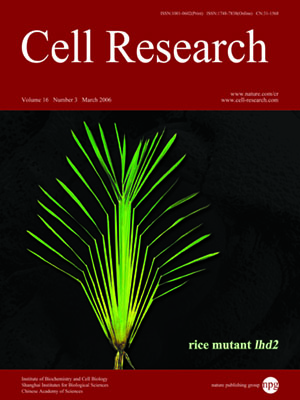
Volume 16, No 3, Mar 2006
ISSN: 1001-0602
EISSN: 1748-7838 2018
impact factor 17.848*
(Clarivate Analytics, 2019)
Volume 16 Issue 3, March 2006: 260-266
ORIGINAL ARTICLES
Cytogenetic comparisons between A and G genomes in Oryza using genomic in situ hybridization
Zhi Yong Xiong1, 2, * , Guang Xuan Tan1, *, Guang Yuan He2, Guang Cun He1, Yun Chun Song1
11Key Laboratory of the Ministry of Education for Plant Developmental Biology, College of Life Sciences, Wuhan University, Wuhan
430072, China; 2China-UK HUST-R Res Genetic Engineering and Genomics Joint Laboratory, Huazhong University of Science and
Technology, Wuhan 430074, China
Correspondence: Guang Cun He, Yun Chun Song(gche@whu.edu.cn; songyc1936@yahoo.com.cn)
The genomic structures of Oryza sativa (A genome) and O. meyeriana (G genome) were comparatively studied using bicolor genomic in situ hybridization (GISH). GISH was clearly able to discriminate between the chromosomes of O. sativa and O. meyeriana in the interspecific F1 hybrids without blocking DNA, and co-hybridization was hardly detected. The average mitotic chromosome length of O. meyeriana was found to be 1.69 times that of O. sativa. A comparison of 4,6-diamidino-2-phenylindole staining showed that the chromosomes of O. meyeriana were more extensively labelled, suggesting that the G genome is amplified with more repetitive sequences than the A genome. In interphase nuclei, 9-12 chromocenters were normally detected and nearly all the chromocenters constituted the G genome-specific DNA. More and larger chromocenters formed by chromatin compaction corresponding to the G genome were detected in the hybrid compared with its parents. During pachytene of the F1 hybrid, most chromosomes of A and G did not synapse each other except for 1-2 chromosomes paired at the end of their arms. At meiotic metaphase I, three types of chromosomal associations, i.e. O. sativa-O. sativa (A-A), O. sativa-O. meyeriana (A-G) and O. meyeriana-O. meyeriana (G-G), were observed in the F1 hybrid. The A-G chromosome pairing configurations included bivalents and trivalents. The results provided a foundation toward studying genome organization and evolution of O. meyeriana.
Cell Research (2006) 16:260-266. doi:10.1038/sj.cr.7310033; published online 16 March 2006
FULL TEXT | PDF
Browse 1897


